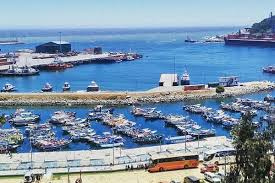What types of cargo are primarily handled at San Antonio’s port?

What types of cargo are primarily handled at San Antonio’s port?
What types of cargo are primarily handled at San Antonio’s port? San Antonio’s port is a bustling hub of activity, known for its diverse range of cargo types.
Understanding the primary cargo handled here gives insight into its economic significance.
Containerized Cargo: The Backbone
The most significant portion of cargo at San Antonio consists of containerized goods. These containers facilitate the efficient transport of a wide array of products.
From electronics to textiles, the port serves as a vital gateway for international trade, connecting Chilean exports and imports to global markets with remarkable efficiency.
Agricultural Products: A Chilean Specialty
San Antonio is particularly renowned for handling agricultural exports. Fresh fruits and vegetables, including grapes, apples, and berries, are shipped to markets worldwide.
Chile’s climate allows for year-round production, making these agricultural products a crucial part of the economy and a staple of San Antonio’s cargo operations.
Mineral Exports: The Heart of Chile’s Economy
Chile is a global leader in copper production, and San Antonio plays a significant role in exporting this vital mineral. Copper concentrates and other minerals are regularly shipped from the port.
These exports are essential to Chile’s economy, contributing substantially to national revenue and reinforcing the port’s importance in the mining sector.
Automobiles and Machinery
The port also serves as a critical entry point for imported automobiles and heavy machinery. This includes vehicles for local dealerships and equipment for industries.
Handling these imports helps meet domestic demand, supporting various sectors like construction and transportation within Chile.
Food Products: A Diverse Range
In addition to fresh produce, San Antonio handles various food products, including processed foods, seafood, and beverages. These cargo types reflect Chile’s rich culinary offerings.
Seafood, in particular, is significant, with Chile being a major exporter of fish and shellfish to international markets, further diversifying the port’s operations.
Bulk Cargo: Handling Natural Resources
San Antonio also manages bulk cargo, including chemicals, fertilizers, and raw materials. This type of cargo supports local industries and agriculture.
The ability to handle bulk materials efficiently enhances the port’s capacity to serve multiple sectors, from manufacturing to farming.
Project Cargo: Specialized Handling
The port has developed expertise in handling project cargo, which includes oversized and heavy items like turbines and construction equipment.
These specialized shipments require careful planning and coordination, showcasing the port’s versatility and capability in accommodating diverse cargo needs.
Import and Export Balance
While San Antonio primarily serves as an export hub, it also facilitates significant imports, ensuring a balanced flow of goods.
This dual role enhances the port’s importance in Chile’s trade ecosystem, allowing for a more integrated supply chain that benefits various industries.
Regional Trade Impact
San Antonio’s cargo operations have a broader impact on regional trade, as it connects smaller ports and inland areas to global markets.
This connectivity promotes economic growth in surrounding communities, ensuring that the benefits of port activities extend beyond its immediate vicinity.
Future Cargo Trends
As global trade evolves, San Antonio is adapting to new cargo trends, including increased demand for e-commerce and sustainable products.
Investments in technology and infrastructure will be crucial for accommodating changing cargo types, ensuring the port remains competitive in the future.
In summary, San Antonio’s port handles a diverse array of cargo types, from containerized goods to specialized project cargo.
Its strategic location and advanced facilities make it a vital hub for Chilean trade, supporting various industries and contributing significantly to the national economy. As global trade continues to shift, San Antonio is well-positioned to adapt and thrive.





Leave a Reply